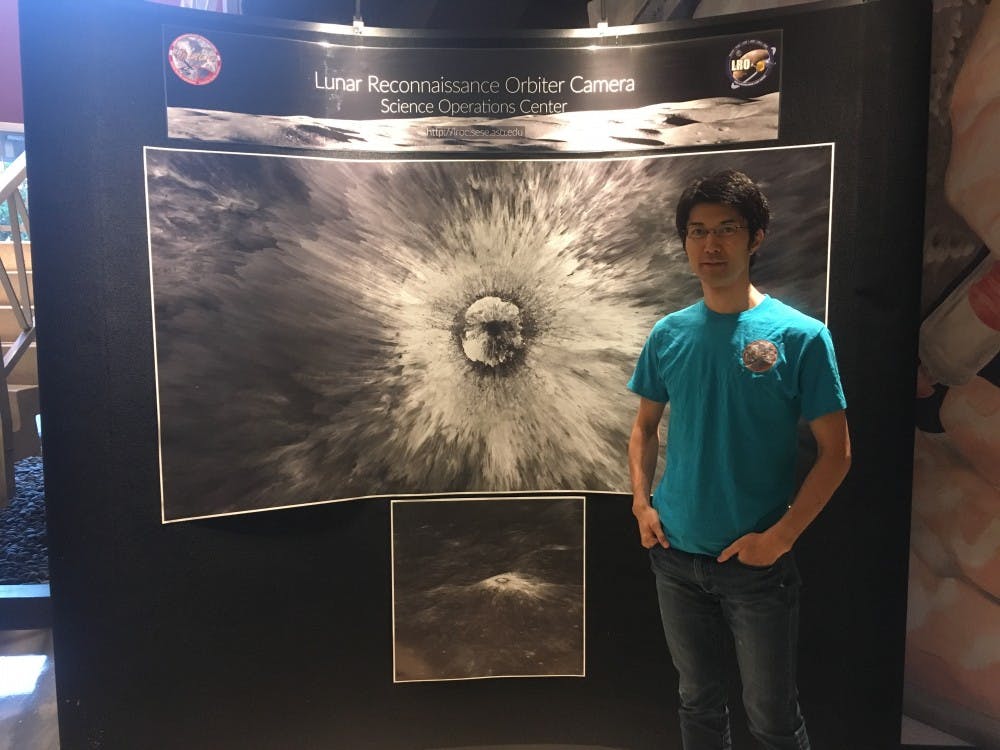While much of ASU's interplanetary research focus in recent months has been on Mars, a large group of University researchers is working to map and photograph the surface of the moon.
The Lunar Orbital Reconnaissance Camera (LROC) team operates a camera which takes high-resolution images of the lunar surface in order to gather information about Earth’s celestial partner.
The orbiter is on lease from NASA and operates both a wide angle and narrow angle camera. These cameras can even change their rotation and can lean and swivel to capture the most useful images.
Since the satellite's launch in 2009, the team at ASU has focused on collecting the best data for NASA to provide vital information about the moon’s surface and geologic makeup for future missions.
Hiroyuki Sato is a scientist from Japan who has worked on planetary missions across the globe, but at the LROC lab he specifically operates the narrow-angle camera. This device uses advanced imaging technology to capture the highest quality photos of the moon’s exterior.
“The narrow-angle camera is actually two telescopes that each take a picture and mosaic them over one another to create a better quality image," Sato said. "This is the only camera which utilizes this technology."
The technique requires a fairly high level of expertise to operate as it is very difficult to layer the images with different lighting. Sato’s main challenge is making sure that the images appear cohesive after they are layered and tell the true story of the surface features.
However, Sato said the original intent of the satellite was not simply to take high quality pictures of the lunar surface.
“NASA was first planning to build a base on the moon, the Constellation Program, so the LROC was to be used for reconnaissance to take pictures with a high resolution camera to find the best candidate location for building the base,” Sato said.
This mission could still be a possibility if NASA decides to launch missions to other planetary bodies from the moon.
Searching through all the data collected by the satellites is a difficult job. It requires sifting through heaps of images to find corrupt data, a duty that falls to Kristen Paris, an ASU alumna and current research analyst for the LROC project.
“My degree is in planetary biology so it’s exciting to be working on this project so that I am still looking at the surface of interstellar bodies,” Paris said.
After starting as an ASU student worker in the lab, Paris began working there full-time after she graduated. Her job is integral to team success because the pure amount of data brought in from the satellite is staggering and sifting through it is no small task.
“We receive thousands of pictures a day," Paris said. "It really is a lot of data we have stored; between our primary and secondary storage systems it’s somewhere around 2.7 petabytes of information."
To put that into context, if this amount of data were converted into MP3 files, there would be enough to play continuously for over 5,000 years.
The man in charge of keeping all of this data and staff in line is Nick Estes, the science operations manager of the LROC project. His goal is to prioritize the tasks that LROC receives from scientists around the world and figure out which are of the utmost importance and where resources should be allocated.
“Any sort of ground lunar expedition either manned or by robot will be based on our data — where to go and where it is safe to land,” Estes said.
The data from the camera has been requisitioned by foreign governments such as China for use in their own lunar missions.
Simply discovering or revisiting old lunar sites is one of the most exciting aspects, uniting humanity’s close connection between the moon and space exploration, Estes said.
“I remember when we first took pictures of the Apollo 17 mission — the last manned mission to the moon," he said. "We were the first to take pictures of the spacecraft for 40 years. We worked all night but then, finally, when we processed the pictures it was amazing."
Reach the reporter at cdemert@asu.edu or follow him on Twitter @dolewayne
Like The State Press on Facebook and follow @statepress on Twitter.




